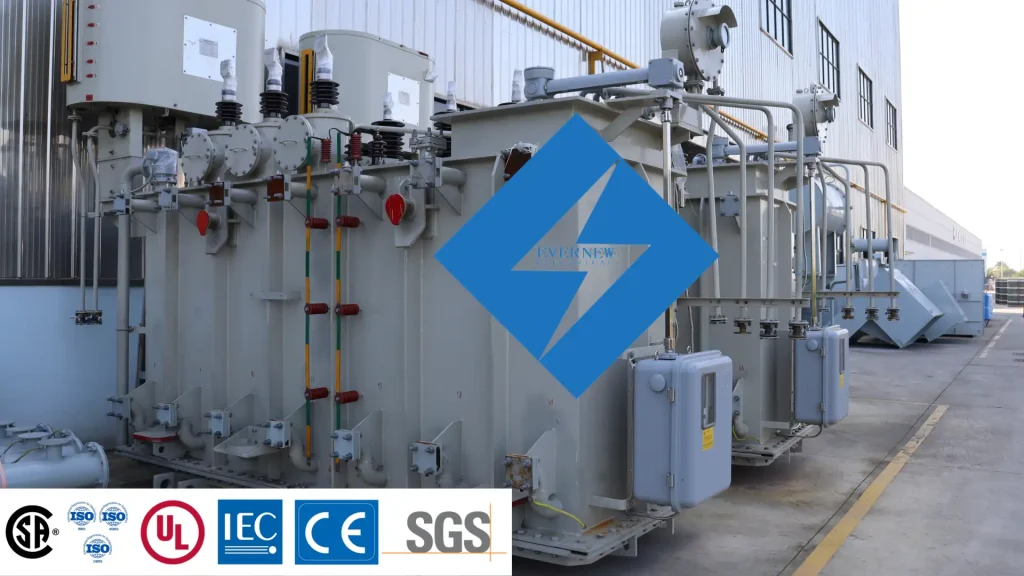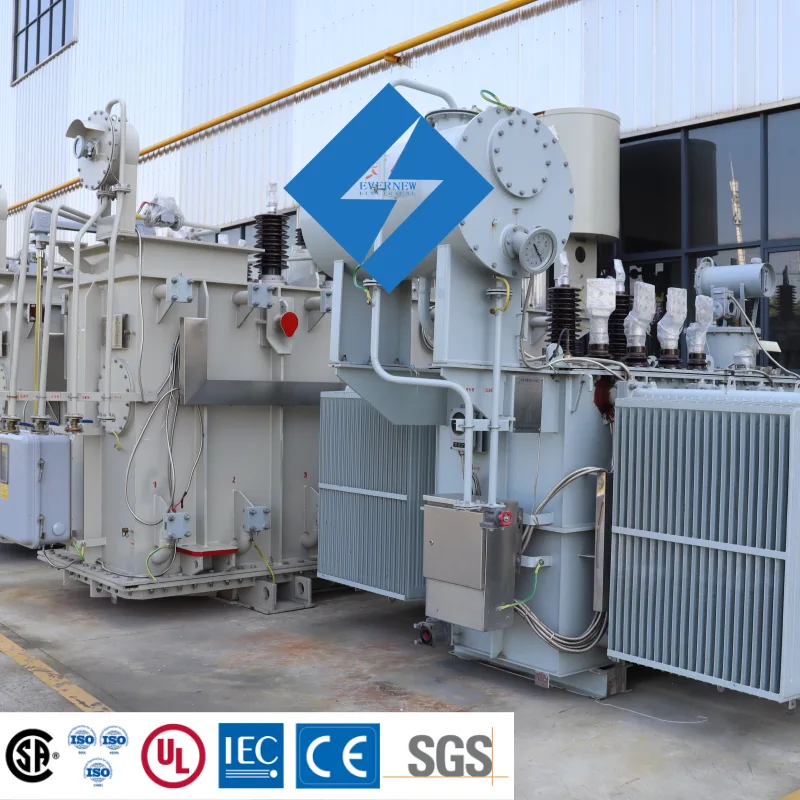What is substation transformer?
A substation transformer is a vital component in power systems, primarily used to step up or step down voltage during electricity transmission. By converting electricity from high-voltage lines at power plants to voltage levels suitable for long-distance transport and end use, substation transformers ensure efficient, stable, and safe delivery of power to various users, including residential, commercial, and industrial sectors. These transformers handle the transition from high voltage transmission to low voltage distribution, ensuring a reliable power supply across different stages.
Beyond basic voltage conversion, substation transformer also manage load responsibilities such as power quality regulation, load balancing, power factor correction, and protection against overloads and short circuits. They help optimize grid operations, reduce energy losses, and enhance power plant efficiency. Substation transformers are designed with specific capacities and voltage ratings, often customized to meet application requirements, ranging from a few kVA to several MVA, and voltage levels that can exceed 500kV. They are essential not only for power distribution but also for maintaining grid stability and ensuring the safety of the electrical network.
Read More:What Is Pole Mounted Transformer
Working principle of substation transformer
A substation transformer operates on the principle of electromagnetic induction. When alternating current flows through the primary winding, it creates a fluctuating magnetic field. This field is coupled through the core to the secondary winding, inducing voltage in the secondary. According to Faraday’s law of induction, output voltage depends on the turns ratio between primary and secondary windings. Adjusting the turns ratio allows a substation transformer to step up or step down voltage.
Substation transformers rely on AC power from the distribution grid. Voltage is generated in the primary coil, creating a magnetic field that induces voltage in the secondary coil, enabling voltage conversion. The primary side typically handles high voltage, while the secondary side is designed for the required lower voltage. This allows transformers to step down high voltage for distribution or step up low voltage for long-distance transmission.
Read More:20000 KVA 33.5kv to 0.44kv Substation Transformer
Types of Substation Transformers
Substation transformers can be classified into various types based on their applications and operating environments. The main types include:
Utility Substation Transformers
These transformers are primarily used by electric power companies to convert high-voltage electricity from power plants into low-voltage electricity suitable for residential, commercial, and industrial use. They typically operate with single-phase or three-phase alternating current and are widely used in both urban and rural distribution systems. Utility transformers are often installed outdoors or in underground facilities to meet various power demands.
Private Industrial Substation Transformers
These transformers supply power to private facilities like factories, hospitals, and schools. They usually receive medium-voltage power from the local utility grid but require dedicated substation transformers to meet specific load requirements. Private industrial transformers are known for their high reliability and large capacity, often installed in more compact spaces.
Underground Substation Transformers
With urbanization increasing, underground substation transformers are becoming the preferred choice in areas with limited space. Due to spatial and environmental constraints, these transformers often require special designs, featuring efficient cooling and insulation systems. Underground substations must also ensure higher safety, durability, and adaptability to elevated temperature and humidity conditions.
Step-Up and Step-Down Substation Transformers
- Step-Up Transformers: These are used to increase low-voltage electricity to a higher voltage suitable for transmission. Step-up transformers are typically located at power plants or far from load centers to minimize energy loss during long-distance transmission.
- Step-Down Transformers: These transformers reduce high-voltage electricity to a lower voltage suitable for consumption. Step-down transformers are commonly placed at the end of distribution networks or near load areas to ensure safe voltage levels for end users.
Oil-Immersed and Dry-Type Substation Transformers
- Oil-Immersed Transformers: These transformers use mineral oil or other insulating oils as cooling and insulation mediums. Due to their simple structure and efficient cooling, oil-immersed transformers are widely used in distribution systems.
- Dry-Type Transformers: These transformers do not use oil and are typically used in environments with high environmental standards, such as indoors, commercial buildings, or hospitals. Without the need for oil as a cooling medium, dry-type transformers are more environmentally friendly and suitable for smaller power loads.
Read More:1500 KVA 11kv Substation Transformer
Key Design Features of Substation Transformers
Core and Coil Structure
The core of a substation transformer is typically made from stacked silicon steel sheets to reduce hysteresis loss. The coil material is usually copper or aluminum to ensure good electrical conductivity. During design, the number of coils and their arrangement are determined based on load requirements and power transmission needs.
Cooling System
Substation transformers generate significant heat due to high voltage and load, making an effective cooling system a crucial part of their design. Common cooling methods include natural oil cooling, forced oil circulation, and air cooling systems. For high-capacity transformers, fans or pumps are often used to enhance cooling efficiency.
Voltage Ratings and Capacity
The voltage range for substation transformers typically spans from 2.4 kV to 69 kV, with secondary voltage generally between 0.6 kV and 35 kV. Capacities range from small transformers with a few hundred kVA to large ones exceeding tens of thousands of kVA, depending on regional and load requirements. Common capacity ratings include 500 kVA, 1000 kVA, 5000 kVA, 20 MVA, and more.
Insulation and Safety
The insulation system of a substation transformer includes oil, gas, and solid insulating materials, designed to prevent leakage of electricity during transmission while effectively preventing short circuits and electrical fires.
Protection Features
Substation transformers are typically equipped with various protection devices such as overload protection, overcurrent protection, and undervoltage protection. These devices ensure that in the event of a grid failure, the transformer can disconnect promptly to prevent damage to the transformer and downstream equipment.
Read More:Optimizing Power Distribution with Medium Voltage Transformer: The Ultimate Guide
Applications of Substation Transformers
Substation transformers have a wide range of applications, primarily in the following areas:
Power Distribution
Substation transformers are used to convert high voltage electricity transmitted from power plants into low voltage electricity suitable for residential, commercial, and industrial use. They are a crucial component of the power system, ensuring that electricity is efficiently and safely delivered to end users.
Industrial Power Supply
In industrial operations, substation transformers provide stable power to heavy equipment, machinery, and high-load electrical systems. These transformers typically require higher capacity and greater resistance to interference to meet the demands of complex industrial environments.
Renewable Energy Integration
With the growing development of renewable energy sources such as solar and wind, substation transformers are increasingly used to connect these variable energy sources to the grid. They play an important role in voltage regulation and grid stabilization, ensuring the reliability and stability of energy supply.
Power Monitoring and Dispatching
As part of the power dispatch and monitoring system, substation transformers help power companies monitor load demand, adjust voltage and current, and ensure the reliability of electricity supply.
Read More:63kv 66kv 69kv High Voltage Power Transformer Manufacturer
Maintenance and Management of Substation Transformers
Maintenance and management of substation transformers are critical to ensuring the stability of the power system and extending their lifespan. Key maintenance tasks include:
Oil Quality Monitoring
Regular testing of the oil in oil-immersed transformers is essential to ensure it is not contaminated and has adequate insulating properties.
Cooling System Inspection
Periodic inspection of the cooling system, including oil pumps, fans, and coolers, is necessary to ensure they are functioning properly and prevent transformer overheating.
Electrical Component Inspection
Regular checks of electrical components such as bushings, tap changers, and grounding devices are necessary to prevent aging or wear and avoid electrical faults.
Load Management
Efficient load distribution across transformers is crucial to prevent overloads and reduce losses, ensuring optimal performance.
Sustainability and Future Trends
As global energy structures shift and electricity demand grows, substation transformers face both challenges and opportunities:
Smart Substations
With advancements in IoT and AI technologies, future substation transformers will have enhanced smart capabilities, enabling real-time monitoring, automatic adjustment, and even predictive fault detection to improve the overall reliability and efficiency of the power system.
Environmental Sustainability
Environmental concerns and sustainability goals require substation transformers to meet higher energy efficiency standards while minimizing environmental impact. This has led to the development and use of oil-free or environmentally friendly oil transformers.
Large Capacity and High Voltage Applications
As the demand for long-distance power transmission increases, the capacity and voltage ratings of substation transformers continue to rise to meet the needs of modern power systems requiring greater capacity and higher voltages.
Conclusion
Substation transformers play a vital role in modern power systems, ensuring the efficient conversion and transmission of electricity from power plants to end users. With advancements in technology, the design and functionality of substation transformers are becoming increasingly intelligent and environmentally friendly, contributing to the ongoing green development and efficient operation of global power systems.
Evernew Transformer is a leading global transformer manufacturer, supplying a wide range of substation transformers to countries such as the United States, Canada, the Philippines, Thailand, Kazakhstan, and many others. With a commitment to innovation, reliability, and sustainability, Evernew Transformer provides tailored solutions for diverse power needs, offering state-of-the-art transformers that meet the highest industry standards. Whether it’s for industrial, residential, or renewable energy integration, Evernew Transformer ensures the stability, safety, and efficiency of power distribution worldwide.



